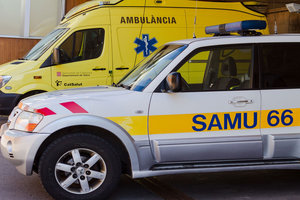News
OECD/DG REGIO project: focus on the Cerdagne cross-border hospital
March 2025
Following publication of the final report and blueprints for each pilot site in the ‘Building more resilient cross-border regions’ project run by the OECD and DG REGIO, the Cerdagne cross-border hospital - one of the pilot sites - gives us its views on the work carried out, its contributions and the specific needs of the area.
Background
In 2023, the OECD and DG REGIO launched a pilot project entitled ‘Building more resilient cross-border regions’, the results and final report of which were published in December 2024. This project involved five pilot sites* located on European borders, selected following a call for expressions of interest. This work also led to the publication of a ‘blueprint’ for each site, which is now available online on the OECD website. To find out more, click here.
Three of these pilot sites are located on the French borders and are part of the MOT network: the Lille-Kortrijk-Tournai Eurometropolis, the Alzette-Belval EGTC and the Hôpital de Cerdagne EGTC.
The case of the Cerdagne cross-border hospital: ten years of cross-border experience and many challenges for the future
‘The work carried out jointly with the MOT and the OECD has demonstrated the relevance of cross-border cooperation, but also the need to find relevant collective responses to problems shared across borders’.
Specific features of the area:
‘As far as the Cerdagne Hospital is concerned, four main issues have been identified:
- the immediate recognition of diplomas for regulated professions, first and foremost doctors, within the European Union in order to avoid excessively long and tedious certification procedures which discourage individual will and hinder recruitment ;
- the need to create an ad hoc status for workers in European groupings of territorial cooperation (EGTCs) in order to put an end to pay inequality and promote equivalent social rights;
- the importance of clarifying and simplifying tax law and social security contributions in cross-border areas in order to give workers and EGTCs legal certainty, which is currently considerably undermined (even where a tax convention has been signed between two states);
- the possibility of day-to-day sharing of emergency and rescue teams and vehicles between France and Spain.’
Follow-up:
‘More than ever, the Cerdagne and Capcir territory must assert itself as the place for experimenting with a specific cross-border law (exceptionality, singularity and deregulation in certain legislative and regulatory aspects)’.
In this respect, bringing together all the French and even European EGTCs within a single representation and lobbying body would enable them to make more effective representations to the public authorities and to be collectively stronger’.
Further information: https://www.hcerdanya.eu/fr/nous-connaitre/
https://www.oecd.org/en/publications/building-more-resilient-cross-border-regions_d5fd3e59-en/support-materials.html
* Border sites: Belgium-France, Lithuania-Poland, Luxembourg-France, France-Spain, Portugal-Spain.
Photo : Hôpital de Cerdagne
Back to list
